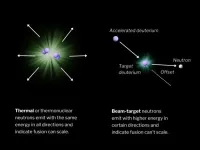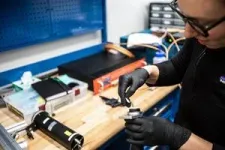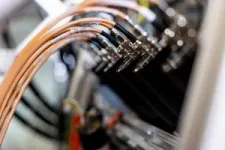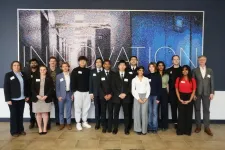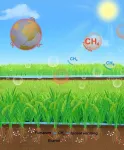(Press-News.org) In physics, the term “isotropy” means a system where the properties are the same in all directions. For fusion, neutron energy isotropy is an important measurement that analyzes the streams of neutrons coming from the device and how uniform they are. This is critical because so-called isotropic fusion plasmas suggest a stable, thermal plasma that can be scaled to higher fusion energy gains, whereas anisotropic plasmas, those emitting irregular neutron energies, can lead to a dead end.
A new Zap research paper, published last week in Nuclear Fusion, details neutron isotropy measurements from the FuZE device that provide the best validation yet that Zap’s sheared-flow-stabilized Z pinches generate stable, thermal fusion. It’s a benchmark milestone for scaling fusion to higher energy yields in Zap’s technology and giving confidence in reaching higher performance on the FuZE-Q device.
“Essentially, this measurement indicates that the plasma is in a thermodynamic equilibrium,” says Uri Shumlak, Zap’s Chief Scientist and Co-Founder. “That means we can double the size of the plasma and expect the same sort of equilibrium to exist.”
Reading the neutrons
Inside a Zap core, hydrogen nuclei are fused into helium, a process that kicks out a neutron at high energies. These neutrons carry 80% of the energy that comes from the fusion reaction, so, in general, the more neutrons, the better.
However, not all kinds of fusion reactions are created equal. Thermal fusion is Zap’s goal — when nuclei are fused together by the extreme heat and pressure inside its plasmas. Thermal fusion produces energetic neutrons that scale exponentially (at around 10 to the eleventh power) as the amount of current conducting through the plasma is dialed up to reach the levels necessary for fusion to yield net energy.
Less desirable is what’s known as beam-target fusion, which happens when a hydrogen nucleus is accelerated to high velocity and strikes a stationary nucleus. Unlike in thermal fusion, beam-target fusion indicates the plasma is out of equilibrium, and therefore doesn’t scale as strongly, making a working energy source much more difficult.
Thermal fusion produces neutrons with isotropic velocities, or with the same energy in all directions, while beam-target fusion produces them anisotropically, or such that neutrons in certain directions have higher energies. So, comparing measurements of the neutron energy at different locations is a simple way to see how much of the fusion in the FuZE device is non-thermal.
“If we saw neutrons primarily from a beam-target source, it would mean that our machine wouldn't be scalable. We couldn't get to net energy production,” says Rachel Ryan, a senior scientist at Zap and lead author of the new research.
To test the neutron isotropy in FuZE, Zap scientists and engineers ran a series of tests using neutron detectors placed around the device. Measuring 433 plasma shots generated with the same machine settings, the neutrons were found to be almost totally isotropic.
A meaningful measurement, in more ways than one
Besides being a key benchmark for physics progress, neutron isotropy holds extra historical significance for Zap’s fusion approach.
The Z pinch is one of fusion’s oldest approaches and dates back to the 1950s. When scientists working on the Zero Energy Thermonuclear Assembly (ZETA) device in the United Kingdom began using magnetic fields to “pinch” a plasma strongly enough to create fusion, they thought they had succeeded. But that success didn’t come in the way they had hoped. Their device turned out to be creating almost entirely beam-target fusion through the creation of instabilities in the magnetic field. That meant they could never generate net-energy-gain fusion. What had been a hopeful moment for the physics community turned out to be a disappointment and a PR disaster.
And while isotropy became a particular black mark for pinch-based approaches, all fusion technologies risk measuring false positives from beam-target neutrons. For example, a device known as a dense plasma focus (DPF) has also been largely dismissed as a practical path to a fusion power plant. Though they are similar in some ways to Zap’s devices and are considered an effective means of generating neutrons, DPF neutrons come primarily from beam-target interactions.
In the shadow of those experiments, Zap is extra conscious of the story its neutrons tell. The company first measured thermal fusion in 2018 and these new tests, done with higher sensitivity and at higher energies, are the latest confirmation that sheared flows can postpone the instabilities that doomed previous Z pinch efforts. Scalable thermal Z-pinch fusion, without requiring any external magnets for confinement, remains promising.
The paper represents a major physics consideration, Shumlak says. “This is why we put so much effort into making these precise measurements,” he says.
Preparing for the future
Since joining Zap in 2023, Ryan has played the lead role in planning and carrying out neutron measurements at Zap, building on work previously done by collaborators and co-authors from Lawrence Livermore National Lab. Next up for the team is running the same set of tests at higher energies on Zap’s FuZE-Q device. Initial results look promising.
“As we continue to scale up, it's important for us to keep taking this measurement and keep checking whether beam-target fusion is contributing to our yields,” Ryan says.
Interestingly, the paper also notes that the neutrons became less isotropic and lost uniformity near the end of each shot. The researchers suggest this is likely a phase where the pinch becomes unstable before it breaks down and stops generating fusion entirely. Understanding that phase may give a better understanding of how to keep the instabilities from cutting fusion short and further increase the duration and performance of the plasma.
END
The right kind of fusion neutrons
A new set of measurements reinforces Zap Energy’s sheared-flow-stabilized Z-pinch fusion approach.
2025-02-03
ELSE PRESS RELEASES FROM THIS DATE:
The cost of preventing extinction of Australia’s priority species
2025-02-03
A new study has estimated it would cost $15.6 billion per year for 30 years to prevent extinction for 99 of Australia’s priority species.
The research, led by Griffith University’s Centre for Planetary Health and Food Security with WWF-Australia and the University of Queensland, highlights the urgent need for increased funding to combat threats such as habitat destruction, invasive species and climate change.
Australia has already lost more than 100 endemic species in the past three centuries, placing it at the forefront of the global extinction crisis.
The ...
JMIR Publications announces new CEO
2025-02-03
(Toronto, February 3, 2025) JMIR Publications, the leading open access publisher in digital health and open science, announced today that Sean Jeong has been appointed as its new chief executive officer (CEO), effective January 23, 2025. Dr Gunther Eysenbach, founder of JMIR Publications, will be stepping down as CEO after over two decades of transformative leadership to focus on new opportunities for innovation in academic publishing, including artificial intelligence (AI)–driven solutions and the advancement of Plan P. He will continue to serve as the editor in chief of the Journal of Medical ...
NCSA awards 17 students Fiddler Innovation Fellowships
2025-02-03
The National Center for Supercomputing Applications awarded Fiddler Innovation Fellowships to 17 University of Illinois Urbana-Champaign and NCSA graduate students in a ceremony January 28 honoring the outstanding achievements and interdisciplinary contributions to NCSA programs Students Pushing Innovation (SPIN) and Design for America during the 2023-24 academic year.
The awards are part of a $2 million endowment from Jerry Fiddler and Melissa Alden to Illinois in support of student ...
How prenatal alcohol exposure affects behavior into adulthood
2025-02-03
Fetal alcohol spectrum disorders (FASD), characterized by symptoms of cognitive decline, such as worsened memory and impaired decision-making, are alarmingly prevalent globally. In a new study in JNeurosci led by Amy Griffin at the University of Delaware, researchers used rats to find brain circuits that may contribute to the cognitive issues that FASD patients experience, with the end goal of informing treatment strategies. Brain regions linked with working memory and decision-making were damaged in baby rats following exposure to alcohol during the age equivalent of the third trimester ...
Does the neuron know the electrode is there?
2025-02-03
Overview:
A research group from the Institute for Research on Next-generation Semiconductor and Sensing Science (IRES²) at Toyohashi University of Technology developed an innovative in vivo electrophysiological neural recording technology that minimizes neuronal death and allows stable recordings for over a year.
This breakthrough involves a 5-µm-diameter microneedle electrode fabricated on a flexible film using silicon-growth technology. Through experiments using mice, the team demonstrated significantly reduced neuronal death and stable neuronal activity recordings compared with traditional electrode technologies, overcoming long-standing challenges in neural recording.
Details:
Long-term ...
Vilcek Foundation celebrates immigrant scientists with $250,000 in prizes
2025-02-03
New York, NY, February 3, 2025 — The Vilcek Foundation has announced $250,000 in awards recognizing immigrant scientists. The 2025 Vilcek Foundation Prizes in Biomedical Science are bestowed as part of the foundation’s annual prizes program in support of its mission.
The Vilcek Foundation Prizes in Biomedical Science are a tribute to Vilcek Foundation co-founder Jan Vilcek, biomedical scientist and philanthropist. Born in Slovakia, Vilcek excelled as a researcher and immunologist, publishing his first single-author paper in Nature at 26. In 1965, with his wife, Marica, he immigrated to the United States ...
Age and sex differences in efficacy of treatments for type 2 diabetes
2025-02-03
About The Study: This systematic review and network meta-analysis of 601 eligible trials found that sodium-glucose cotransporter 2 (SGLT2) inhibitors and glucagon-like peptide-1 (GLP-1 receptor agonists were associated with lower risk of major adverse cardiovascular events. Analysis of age × treatment interactions suggested that SGLT2 inhibitors were more cardioprotective in older than in younger people despite smaller reductions in hemoglobin A1c; GLP-1 receptor agonists were more cardioprotective in younger people.
Corresponding Author: To contact the corresponding author, Peter Hanlon, PhD, email peter.hanlon@glasgow.ac.uk.
To access the ...
Octopuses have some of the oldest known sex chromosomes
2025-02-03
The octopus just revealed another one of its secrets: what determines its sex.
University of Oregon researchers have identified a sex chromosome in the California two-spot octopus. This chromosome has likely been around for 480 million years, since before octopuses split apart from the nautilus on the evolutionary tree. That makes it one of the oldest known animal sex chromosomes.
The finding also is evidence that octopuses and other cephalopods, a class of sea animals that includes squid and nautiluses, do use chromosomes to determine their sex, answering a longstanding mystery among biologists.
“Cephalopods are already such interesting creatures, ...
High-yield rice breed emits up to 70% less methane
2025-02-03
Rice cultivation is responsible for around 12% of global methane emissions, and these emissions are expected to increase with global warming and as the human population continues to grow. Now, scientists have identified chemical compounds released by rice roots that determine how much methane the plants emit. On February 3 in the Cell Press journal Molecular Plant, they report that this information enabled them to breed a new strain of rice that emits up to 70% less methane.
“This study shows that you can have low methane and ...
Long COVID prevalence and associated activity limitation in US children
2025-02-03
About The Study: In 2023, post–COVID condition (PCC) continued to affect U.S. children at similar levels as 2022 and to have similar sociodemographic patterns. The large proportion of children experiencing PCC with any activity limitation highlights the need to examine the severity of activity limitation, functional outcomes, and days lost from school.
Corresponding Author: To contact the corresponding author, Nicole D. Ford, PhD, MPH, email yex9@cdc.gov.
To access the embargoed study: Visit our For The Media website ...
LAST 30 PRESS RELEASES:
Tracing the quick synthesis of an industrially important catalyst
New software sheds light on cancer’s hidden genetic networks
UT Health San Antonio awarded $3 million in CPRIT grants to bolster cancer research and prevention efforts in South Texas
Third symposium spotlights global challenge of new contaminants in China’s fight against pollution
From straw to soil harmony: International team reveals how biochar supercharges carbon-smart farming
Myeloma: How AI is redrawing the map of cancer care
Manhattan E. Charurat, Ph.D., MHS invested as the Homer and Martha Gudelsky Distinguished Professor in Medicine at the University of Maryland School of Medicine
Insilico Medicine’s Pharma.AI Q4 Winter Launch Recap: Revolutionizing drug discovery with cutting-edge AI innovations, accelerating the path to pharmaceutical superintelligence
Nanoplastics have diet-dependent impacts on digestive system health
Brain neuron death occurs throughout life and increases with age, a natural human protein drug may halt neuron death in Alzheimer’s disease
SPIE and CLP announce the recipients of the 2025 Advanced Photonics Young Innovator Award
Lessons from the Caldor Fire’s Christmas Valley ‘Miracle’
Ant societies rose by trading individual protection for collective power
Research reveals how ancient viral DNA shapes early embryonic development
A molecular gatekeeper that controls protein synthesis
New ‘cloaking device’ concept to shield sensitive tech from magnetic fields
Researchers show impact of mountain building and climate change on alpine biodiversity
Study models the transition from Neanderthals to modern humans in Europe
University of Phoenix College of Doctoral Studies releases white paper on AI-driven skilling to reduce burnout and restore worker autonomy
AIs fail at the game of visual “telephone”
The levers for a sustainable food system
Potential changes in US homelessness by ending federal support for housing first programs
Vulnerability of large language models to prompt injection when providing medical advice
Researchers develop new system for high-energy-density, long-life, multi-electron transfer bromine-based flow batteries
Ending federal support for housing first programs could increase U.S. homelessness by 5% in one year, new JAMA study finds
New research uncovers molecular ‘safety switch’ shielding cancers from immune attack
Bacteria resisting viral infection can still sink carbon to ocean floor
Younger biological age may increase depression risk in older women during COVID-19
Bharat Innovates 2026 National Basecamp Showcases India’s Most Promising Deep-Tech Ventures
Here’s what determines whether your income level rises or falls
[Press-News.org] The right kind of fusion neutronsA new set of measurements reinforces Zap Energy’s sheared-flow-stabilized Z-pinch fusion approach.
